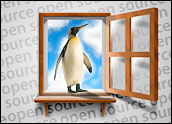
![]()
The Enlightenment desktop environment is not for everyone. Experienced Linux fans may delight in some new light bulbs switching on, but Linux newcomers may find themselves groping in the darkness.For the Linux-initiated, Enlightenment offers some powerful new flexibility in how to set up and use the operating system. Note — Linux experience will not make your journey to one of the least known graphical user interfaces in the Linux OS a fully pleasant trip, but once you get there, you will probably like your surroundings.
Enlightenment 0.18.7, or E18, is the latest version of the Compositing Window Manager and Desktop Shell. Enlightenment is the only option in several Linux distributions, and it is radically different from other lightweight interface shells such as Xfce and LXDE.
Enlightenment is lightweight, so it runs of lots of legacy desktops and laptops. It also is very customizable. This desktop offers a basic core design — but the design is tweaked and integrated differently depending on which supporting Linux distro you use.
This core design gives Enlightenment users certain functionality that can change your approach to using Linux. For example, its menu pops up from any point of the desktop instead of being in a single place. Also, the traditional panel functionality may or may not be part of the interface, depending on the supporting distro. Press the Control +Alt+M keys to display the menu.
Becoming Enlightened
Getting and installing the Enlightenment desktop is not as simple as moving into other desktop choices. Most standard Linux distros do not have an Enlightenment version or even a shell package to grab from the system repository. So be careful where and how you apply any changes.
Over the last few years, some Linux distros that experimented with an Enlightenment version dropped it completely. A few current distros offer out-of-date versions. Some so-called Enlightenment distros are so minimalistic in design and package support that using them comes close to staring at a blank black screen.
There are Linux distro forums that have instructions for adapting your system to install an add-on Enlightenment package. Do not go there. I followed one prominent approach hawked on an Ubuntu user forum and rendered my recent installation of Ubuntu 14.04 desperately needing a complete reinstallation.
Since Enlightenmnt uses a different set of system tools to handle Internet connectivity, I had to install strange packages. The Enlightenment shell failed to load. The system no longer connected to the Internet. Clearly, this is a software and driver issue. Other Linux distros booting from a USB drive connected just fine.
What to Do
Another approach you should not take is to download the Enlightenment installation from the project’s website at Enlightenment.org. Far too many dependency issues will arise with every variation of Linux distro you might have.
Instead, tread lightly where I have already gone. My original plan was to review a Linux distro that was based on Enlightenment. I found four of the leading Enlightenment distros, but each one’s implementation was radically different.
I checked out how Enlightenment is used in four Linux distros: Manjaro, Macpup, Elive and Bodhi.
Shedding Some Light
In its infancy, Enlightenment started out as a window manager for Linux/X11. It grew into a suite of 10 core libraries to create beautiful user interfaces with much less work. Each library fulfills a purpose, and all are not needed in every distro integration.
Enlightenment is used on a wide range of hardware — from small mobile devices like phones to powerful multicore desktops. It also is used in some set-top boxes and game systems.
The Enlightenment Foundation Libraries, or EFL, are part of Enlightenment’s basic building blocks. These provide a semitraditional toolkit dubbed “Elementary” and an object canvas called “Evas.” Enlightenment also has abstracted objects titled “Edje” that let users combine, mix and match, or layer with alpha channels and events intact. Enlightenment has 3D transformations for all objects and much more.
Enlightenment is not solely for Linux. The shell and the EFL support several platforms. It also is used on FreeBSD and other BSD distros, Solaris, Mac OS X and some Windows installations.
The Mac Experience
Of the four distros used to illustrate the Enlightenment desktop, I found the Macpup Enlightenment version to be the most similar to other versions. I am a long-time Puppy Linux fan. Macpup Linux 550 is based on Precise Puppy 5.5.0 and is an official woof build of Puppy Linux that is binary-compatible with Ubuntu Precise packages.
It is one of the few Enlightenment distros that has strong compatibility with other distro versions. Like all Puppy Linux derivatives, Macpup is a fast, small, light OS. It runs in RAM but is not a stripped- down, bare bones, basic core OS. Macpup contains all the apps from Precise Puppy with the addition of Firefox 22. It includes the Enlightenment E17 window manager. The EFL libraries version 1.7.5 and E17 version 17.0 are compiled and installed from source.

Macpup required the least amount of relearning of the Enlightenment distros I reviewed. Because I am familiar with the Puppy Linux structure, the only thing hugely different was the Mac OS-like docking bar at the bottom of the screen. Much like a panel, the first icon on the far left activates the menu.
I felt right at home with the familiar ROX-Filer file management system as well. Even the right-click anywhere pop-up menu worked much like the left-click menu activation the other Puppy Linux versions use.
Loving the Elive Linux Way
The integration of Enlightenment in the Elive Linux distro is more refined than the other distros I sampled. It has a pager display of six virtual desktop thumbnails in the upper right corner of the screen. Just click on a square to move to that virtual workspace.
Elive has a Mac OS style dock on the bottom. As you traverse the pointer over the icons, they get bigger. However, Elive does not have a main menu icon.
Elive provides animated elements like backgrounds, icons, widgets and the terminal. It makes possible an animated desktop with 3D effects without an accelerated graphic card. If you take the time to fiddle with its design controls, you can finesse its desktop appearance and functionality like a painter creating a scene on a canvas.
The Arch-etypal Manjaro Approach
I have used the standard Manjaro Linux distro. The specially tooled Manjero Enlightenment version gives this distro a completely new look and feel.
Enlightenment works neatly within this Arch operating system-based Manjaro distro. Until you navigate through the shell, the outer appearance is a close match for a typical Linux distro with panel bar at the bottom of the screen. It even has a menu button at the far left of the bottom panel.

This Enlightenment distro maintains the panel functionality in that notification icons and quick launch icons populate the panel. However, like all iterations of Enlightenment, that is where the similarity ends. Using the settings and system controls takes time to learn.
If you want a collection of applications that you already know how to use, start here. It is the only distro I sampled that included a basic set of software you would expect in a bare-bones offering.
Manjaro is also the only distro among those I sampled for this Enlightenment introduction that uses a Rolling Release Development Model. That is the Manjaro way, and it is nice not to have to reinstall completely with each new release. Instead, the same core system is continually updated and upgraded.
Full Bodhi Elegance
Bodhi Linux leverages the speed and highly customizable Enlightenment Desktop with an elegance that makes it a new experience. The background art options are gorgeous compared to the standard fare in the other sampled Enlightenment distros.
Bodhi has an easy-to-use workplace switcher on the desktop. It also is the only one that places such a prominent use of gadgets on the desktop. Bodhi includes a docking bar at the bottom with special animation effects.

Like the other three Enlightenment-based distros samples, however, the system tools are very different from standard desktop environments. The few preinstalled applications are different from the stock apps used in the other distros as well.
Bodhi’s developers take the user choice concept to a higher level. Users add to a small set of default utilities just the applications they need. Installation is handled from the Bodhi App Center, apt-get, or Synaptic.
The distro follows the Ubuntu LTS (Long Term Support) release cycle for the core of its distribution. In between these major releases, the developers backport software so all of the installed software stays current. Thus, users only need to reinstall their system every two years. Bodhi releases are supported and get security updates for as long as the LTS base is supported by Ubuntu.
Bottom Line
The Enlightenment experience is not for all Linux users, especially less-experienced ones. Regardless of which Enlightenment distro you use, you get only a minimal set of utilities. Even so, the browser, text editor and package management tools are probably not the commonly known apps you use in your present distro. Also, there is no common core of basic software found among the Enlightenment distros.
Learning how to navigate within the Enlightenment shell is where the learning curve occurs. A second, steeper curve involves figuring out how to massage the seemingly endless options to customize the desktop functionality.
If you have lots of time to devote to learning something new within something old, check out Enlightenment — but do it through a distro built around it. Do not try to do your own Enlightenment integration by manually adding Enlightenment packages to your current Linux distro.























































"There are Linux distro forums that have instructions for
adapting your system to install an add-on
Enlightenment package. Do not go there. I"
"… but do it through a distro built around it. Do not try to do your own Enlightenment integration by manually adding Enlightenment packages to your current Linux distro."
I do not fully agree with this. It is true that you should NOT add Enlightment to your fully functional Desktop Environment.
However, another approach you did not talked about is installing your favorite Linux distribution from scratch on your computer, but without any Desktop Environment nor Window Manager at all. This way you keep your habits, like using a Debian, Gentoo, Arch base.
For Debian/Ubuntu this can be accomplished using the "netinstall/mini" iso and not choosing any Desktop Environment during installation process. Then you just have to install a Display Manager like LightDM and you are ready to install Enlightenment.
Just follow instructions for installation from Enlightenment documentation page, in most case you just have to use dedicated repositories.
You end up with a fresh and clean E installation.